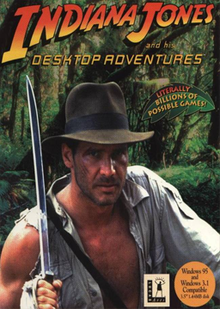
Day of the Tentacle, also known as Maniac Mansion II: Day of the Tentacle, is a 1993 graphic adventure game developed and published by LucasArts. It is the sequel to the 1987 game Maniac Mansion. The plot follows Bernard Bernoulli and his friends Hoagie and Laverne as they attempt to stop the evil Purple Tentacle - a sentient, disembodied tentacle - from taking over the world. The player takes control of the trio and solves puzzles while using time travel to explore different periods of history.

Indiana Jones and the Last Crusade: The Graphic Adventure is a graphic adventure game, released in 1989 by Lucasfilm Games, coinciding with the release of the film of the same name. It was the third game to use the SCUMM engine.
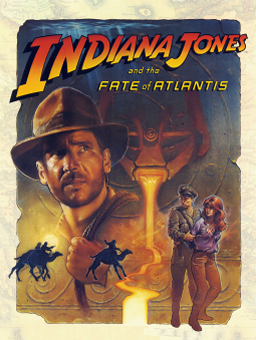
Indiana Jones and the Fate of Atlantis is a point-and-click adventure game developed and published by LucasArts and released in June 1992 for Amiga, DOS, and Macintosh. Almost a year later, it was reissued on CD-ROM as an enhanced "talkie" edition with full voice acting and digitized sound effects. The seventh game to use the script language SCUMM, Fate of Atlantis has the player explore environments and interact with objects and characters by using commands constructed with predetermined verbs. It features three unique paths to select, influencing story development, gameplay and puzzles. The game used an updated SCUMM engine and required a 286-based PC, although it still runs as a real-mode DOS application. The CD talkie version required EMS memory enabled to load the voice data.
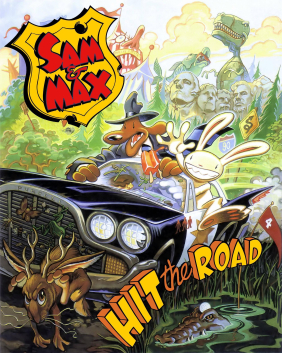
Sam & Max Hit the Road is a graphic adventure video game released by LucasArts during the company's adventure games era. The game was originally released for MS-DOS in 1993 and for Mac OS in 1995. A 2002 re-release included compatibility with Windows. The game is based on the comic characters of Sam and Max, the "Freelance Police", an anthropomorphic dog and "hyperkinetic rabbity thing". The characters, created by Steve Purcell, originally debuted in a 1987 comic book series. Based on the 1989 Sam & Max comic On the Road, the duo take the case of a missing bigfoot from a nearby carnival, traveling to many American culture tourist sites to solve the mystery.
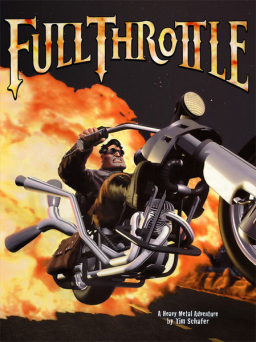
Full Throttle is a 1995 graphic adventure video game developed by LucasArts and designed by Tim Schafer. It was Schafer's first game as project lead and head writer and designer, after having worked on other LucasArts titles including The Secret of Monkey Island (1990), Monkey Island 2: LeChuck's Revenge (1991), and Day of the Tentacle (1993). Set in the near future, the story follows motorcycle gang leader Ben, who must clear his name after being framed for the murder of a beloved motorcycle manufacturing mogul. A remastered version of the game was developed by Double Fine Productions and was released in April 2017 for Windows, PlayStation 4 and PlayStation Vita, with later ports for iOS and Xbox One.
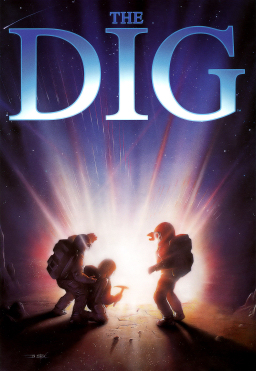
The Dig is a 1995 point-and-click adventure game developed by LucasArts for PC and Macintosh. Like other LucasArts adventure games, it uses the SCUMM video game engine. It features a full voice-acting cast, including voice actors Robert Patrick and Steve Blum, and a digital orchestral score. The game uses a combination of drawn two-dimensional artwork and limited, pre-rendered three-dimensional clips, with the latter created by Industrial Light & Magic.

Return to Zork is a 1993 graphic adventure game in the Zork series. It was developed by Activision and was the final Zork game to be published under the Infocom label.
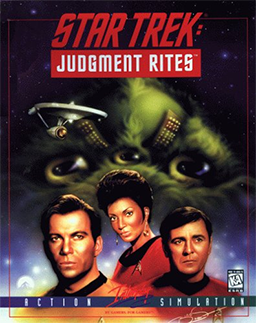
Star Trek: Judgment Rites is a computer game first produced by Interplay Productions in 1993, featuring the original cast of the classic Star Trek in a series of new adventures, including one featuring Trelane, the omnipotent child from the original episode "The Squire of Gothos". Judgment Rites uses the same MS-DOS game engine as the earlier Star Trek: 25th Anniversary; however, it had sharper graphics and sound, particularly with the CD-ROM edition. All of the initial cast members provided voices for their characters on the game in that edition. William Campbell also reprised his guest role as Trelane.
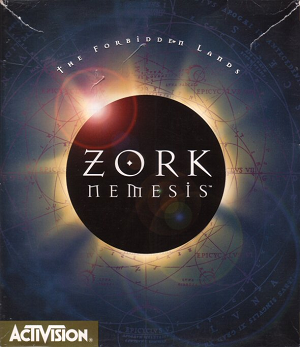
Zork Nemesis: The Forbidden Lands is a graphic adventure game developed by Zombie LLC, published by Activision, and released in 1996 for Windows 95, MS-DOS, and Macintosh. It is the eleventh game in the Zork series, and the first title not to be marketed under the Infocom label, while featuring a darker, less comical story within the Zork setting. The story focuses on players investigating the sudden disappearance of four prominent figures and their children to the hands of a mysterious being known as the "Nemesis", and uncovering a sinister plot during their investigations that they must thwart. The game features performances by Lauren Koslow, W. Morgan Sheppard, Allan Kolman, Stephen Macht, Paul Anthony Stewart, Merle Kennedy, and Bruce Nozick.
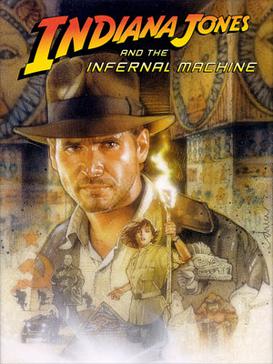
Indiana Jones and the Infernal Machine is an action-adventure video game by LucasArts released in 1999. The first 3D installment in the series, its gameplay focuses on solving puzzles, fighting enemies, and completing various platforming sections. The story is set in 1947, after the events of Indiana Jones and the Iron Phoenix, and puts the eponymous protagonist, the adventurer Indiana Jones, against the Soviet Union. In a race for a mythological Babylonian power source, he joins forces with the Central Intelligence Agency and collects four pieces of the Infernal Machine, an ancient device that allegedly opens a portal to another dimension.

Star Wars: Yoda Stories is a 1997 adventure video game based on the Star Wars franchise developed by LucasArts. The game is the second and last title in LucasArts' Desktop Adventures series, preceded by Indiana Jones and His Desktop Adventures. The game was released in March 1997 for Microsoft Windows and ported to Game Boy Color by Torus Games in December 1999.

Shannara is a computer game released in 1995 for the MS-DOS and Microsoft Windows. It is based on the Shannara series of books by Terry Brooks.

Rama is a point and click adventure game, developed and published by Sierra On-Line, and released on DOS and Microsoft Windows in 1996; PlayStation version was released in 1998, but exclusively in Japan. The game is based upon Arthur C. Clarke's books Rendezvous with Rama and Rama II, combining elements of their plots with a story that sees the player assuming the role of a replacement crew member for an expedition to investigate an instellar ship and uncover its mysteries.
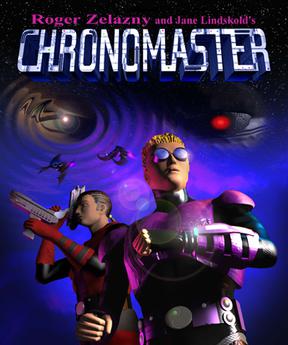
Chronomaster is an adventure game developed by DreamForge Intertainment for MS-DOS compatible operating systems and published by IntraCorp on 20 December 1995. Its main plot was written by novelist Roger Zelazny and was his last known work, as he died during the development of the game. Due to Roger's passing, Dreamforge used in-house puzzle and game designers John McGirk and Aaron Kreader to complete a majority of the game puzzles, while leaving the overall game plot and concept intact as per Roger's vision.

I Have No Mouth, and I Must Scream is a 1995 point-and-click adventure horror game developed by Cyberdreams and The Dreamers Guild, co-designed by Harlan Ellison, published by Cyberdreams and distributed by MGM Interactive. The game is based on Ellison's short story of the same title. It takes place in a dystopian world where a mastermind artificial intelligence named "AM" has destroyed all of humanity except for five people, whom he has been keeping alive and torturing for the past 109 years by constructing metaphorical adventures based on each character's fatal flaws. The player interacts with the game by making decisions through ethical dilemmas that deal with issues such as insanity, rape, paranoia, and genocide.

Amber: Journeys Beyond is an American computer game released in 1996 for Apple Macintosh computers and Windows 95. It is the only game produced by Hue Forest Entertainment, founded by Frank and Susan Wimmer.

The Lost Files of Sherlock Holmes is an adventure game developed by Mythos Software and published by Electronic Arts for MS-DOS in 1992 and 3DO in 1994. A sequel was developed and published by the same respective companies in 1996 titled The Lost Files of Sherlock Holmes: The Case of the Rose Tattoo.

Normality is a 3D graphic adventure, released in June 1996 by Gremlin Interactive. All cut-scenes in the game are pre-rendered. The game's engine was later used in the game Realms of the Haunting. It was re-released in 2011 with Microsoft Windows support on GOG.com, with macOS support following in 2013 and Linux support in 2014.

Entomorph: Plague of the Darkfall is a 1995 action-adventure role-playing video game by Strategic Simulations, Inc. It was re-released in 2013 on GOG.com.

Blue Force is an adventure game for MS-DOS released in 1993 by former Police Quest designer Jim Walls.
